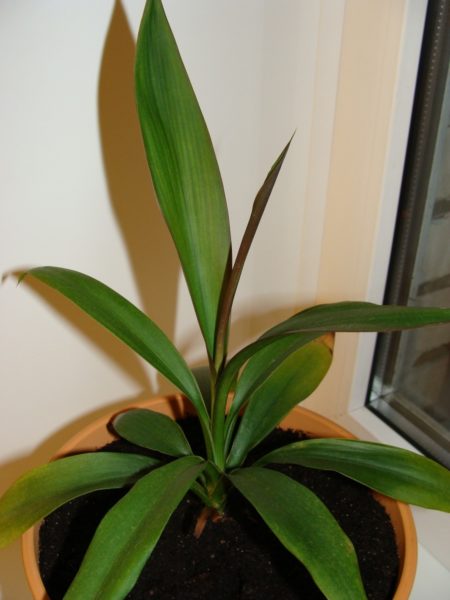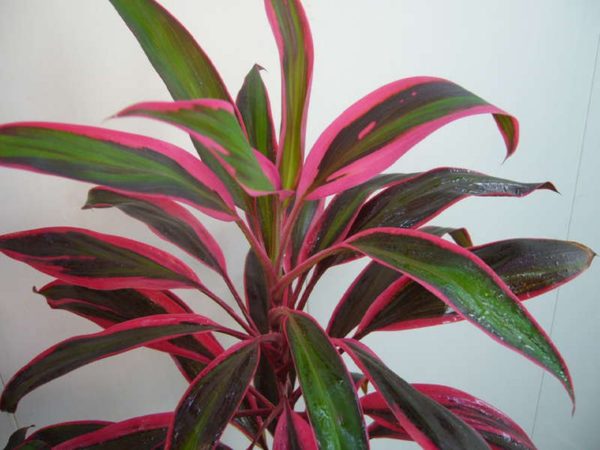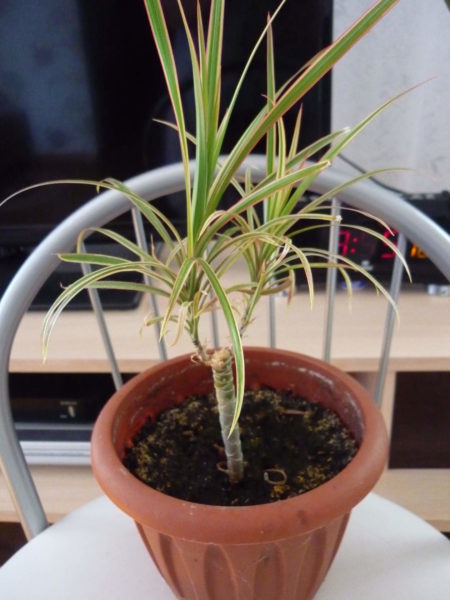Features of the popular houseplant Cordilina
An amazingly beautiful plant has long gained universal popularity. It is appreciated for a huge number of varieties, unpretentious care and the ability to elegantly and appropriately complement any interior.

Cordilina or Dracaena?
The dispute about whether there is a difference between these plants, or whether these are just different names for the same culture, does not subside for many years. But there is still a difference. First of all, plants can be distinguished by their leaves. Dracaena leaves do not have petioles, and the veins are parallel to each other. In Cordilina, on the contrary, the petioles are quite long, in some species they reach 15 centimeters. And the veins on the leaves are arranged in a classic way: one main in the middle and secondary ones depart from it.

Another way to distinguish dracaena from cordilina is to pay attention to the root. Interesting fact: the name itself, "cordilina", is of Latin origin and literally means "bump" or "knot". So on the root there are characteristic thickenings or cones, and the root cut is white, while the dracaena cut has an orange-yellow color.

Another difference between the two plants is quite relative, but, according to fans of domestic cultures, it still has a place to be. Dracaena is more picky about care, does not take root well after transplants, while her distant relative is more resistant to changes.

Types of cordilina
Where did the indoor cordilin flower come from? This perennial plant is a member of the agave family. It is found naturally in the rainforests of Australia, Brazil and New Zealand. Under natural conditions, this tree easily reaches 16 meters in height. In apartments it grows rather slowly, but even a novice florist can grow a cordilina 1.5 meters "tall".

And if in its "youth" the plant has many leaves, then with age it loses leaves almost along the entire trunk, leaving only a shaggy crown. Therefore, in the common people, the cordilina is often called a palm tree. Although, in fairness, it should be noted that such a name is not entirely correct.

There are many varieties of this popular houseplant. Let's dwell on the most demanded ones.
Australian
In nature, a tree can reach 12 meters in height. The trunk is wider at the base and thinner at the crown. The leaves are shaped like a sword, have a rich green color and noticeable whitish veins. The Australian cordilina blooms with small white flowers with a pleasant aroma.

Straight
This variety has a much thinner trunk than the Australian one. In height, a straight cordiline rarely reaches more than 3 meters. The leaves are leathery to the touch, have jagged edges, and are elongated-lanceolate in shape.The length of the leaves reaches 50 centimeters, and the width is 3 cm. During the flowering period, the inflorescences emerge from the axils of the leaves and are small lavender flowers.

Red
The name of this type of cordilina speaks for itself. "Red" because the leaves have a color unusual for plants. It is a shrub and grows up to 4 meters in the wild. It usually doesn't branch. Leaves grow up to half a meter in length, and grooved cuttings can be up to 15 centimeters. It is one of the few species that "prefers" a cool habitat.

Apical
Another name is shrub cordilina. It is a shrub with a thin and fragile trunk. A bush may have several trunks. Leaves are lanceolate fleshy, up to 50 cm long and up to 10 cm wide. The color of the leaves is either green or with a purple tint. Green streaks are visible on the surface.

Cordilina kiwi
Under natural conditions, this variety reaches 2-3 meters in height. In pots, it grows up to 1.5 meters, no more. A characteristic feature is the bright green color of the leaves with purple edging. Moreover, the greenery on the surface of the leaf is not uniform, darker stripes alternate with lighter ones. The leaves are hard, juicy and with a rounded top.

Home care
Unfortunately, not all species of this exotic plant can be grown indoors. Usually, this tropical beauty lacks light, space and humidity - the air in apartments (especially in the autumn-winter period) is too dry for her.
Comfortable conditions:
- Temperature 8 - 23 degrees above zero. It can withstand +13 in winter if it is not watered.
- Air humidity. Especially in winter, it is required to spray the plant up to 7 times during the day and keep it away from batteries. To moisten the soil, the plant is placed in a pallet with wet expanded clay. If this is not done, the leaves begin to dry first, and then the whole plant may die.
- Lighting. Plants with green leaves prefer a little shade, while bright-leaved plants grow better in diffused bright light.
- Watering. In winter, the plant is watered once a week, and the rest of the time - 2 times. It is necessary to ensure that the soil dries out no more than 3 centimeters.
- Priming. The ideal plant mix is 1 part peat, 3 parts soil, and 1 part sand.
- It is recommended to feed the plant only in the summer, once every 14 days, with liquid fertilizer and immediately after watering.
- Transfer. Mature plants are transplanted once every three years, and young plants - annually (if necessary), each time choosing a larger pot (about 2 cm) than the previous one. The plant gives few side shoots, and the root system grows deeper, so give preference to tall pots. An important point: the transplant should be carried out only when the roots of the plant begin to go "outside" the pot. And every year you can simply replace the topsoil. And do not forget about drainage - put a layer of expanded clay on the bottom, without it, the root system will begin to rot.
- Reproduction. There are enough options here: by dividing the bush, by apical or stem cuttings, as well as by seeds.
Video: Dracaena care
In general, the plant is considered unpretentious, but there are some features that must be taken into account. So, in many species, the trunk is long and thin. To prevent it from breaking, you need to find a suitable support for it: a tube wrapped in coconut fiber, or bamboo sticks. If the barrel is thick, then no support is needed.

Be sure to keep the plant out of the draft. You should also avoid sudden changes in temperature. If you need to stimulate the growth of young leaves, cut off the weak shoots. Be sure to wipe the leaves with a soft and damp cloth, thanks to this the plant will always look good, and this will also give additional moisture.

Reproduction
As already mentioned, this plant can be "propagated" either by division, or by cuttings, or by seeds. At the same time, it is worth noting that the last option is suitable only for species plants, because when growing and seeds of varietal options, they lose the signs of their "parents". The ideal time for sowing is the first half of March.

The correct soil plays an important role in the degree of germination. Ideally, this should be a mixture of 1 part turf and 1 part sand. The seeds are placed in the soil to a depth of 1 cm, not more. Cover the pot with plastic wrap. And one more important point: do not expect the simultaneous emergence of all seeds.

The former will appear within a month after planting, and the latter only after three months, and this is a normal process. It is necessary to transplant young plants into separate pots no earlier than the fourth true leaf appears.

If you like working with cuttings more, then remember that the key to success is in the right choice of planting material. So the stalk must have at least 1 knot. By the way, not only the tops of the plant are suitable, but also parts of the leafless shoot. But the planting material should already be a little lignified.

For rooting, the most suitable will be a substrate of peat soil, sand and humus soil, taken in equal proportions. It is better to place the container with planting material in a warm place (25 - 30 degrees is ideal) and regularly moisten it from a spray bottle. In a good scenario, after four weeks, the cuttings will be ready for planting in separate pots. The mixture of soil for planting is slightly different: humus, peat soil, sand and turf soil in equal proportions.

Another way to propagate this plant is by dividing. Perhaps the easiest option. It is recommended to cut off all the roots of the “fragment” separated from the main plant and place it in the mixture, which is used for rooting cuttings. And after the plant gives roots, transplant it into soil mixture for planting adult specimens.

Even in the case when a shoot accidentally breaks off from the main plant, you can try to root it. But this is an exception to the rule. The broken part is cut evenly and placed in a jar of water, which is covered with a dark film (or paper). If light gets in, the plant will not give roots. A little special substance can be added to the water to promote the formation of the root system.

Diseases and pests
Almost any houseplant sooner and later is attacked by pests or some kind of disease. The secret of success in dealing with them is the early identification of the problem and the early adoption of measures to resolve it.
- If brown tips appear on the leaves of the cordilina, then the room is not humid enough;
- Falling leaves are not a problem, but a natural process. Don't worry;
- Brown spots on the leaves are also a lack of moisture;
- Bush rot is a problem that indicates that you have flooded the plant. You will have to root it again, and for this, cut off the top and place it in a special substrate;
- Curling foliage. Usually, this is an indicator that the plant is "frozen".
Video: Dracaena pests
Aphids and scale insects pose a serious threat to culture. But noticing their presence in time, there is a chance to solve the problem without serious losses. There are a variety of spray products available today that can help you get rid of pests once and for all.

Important: in order to detect the problem in time, inspect the plant during each watering, then you can get rid of intruders at the earliest stage.
Care tricks
For the leaves to have a rich green color, ventilate the room every day. The inflow of fresh air enhances metabolic processes.

In addition, so that the leaves do not lose their brightness in the autumn-winter period, take care of additional lighting in the room. And in order to stimulate the growth of plants in the spring, water them with a mixture of chicken manure and water in a ratio of 1:20.

An interesting fact: there are no superstitions or signs regarding Cordilina. Therefore, when answering the question: to plant such a plant in your apartment or not, consider only your personal preferences. And do not hesitate, this spectacular plant will be able to turn the most modest apartment or small office into a stylish and comfortable room.























































